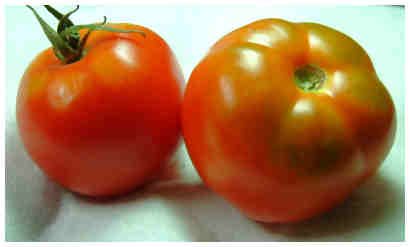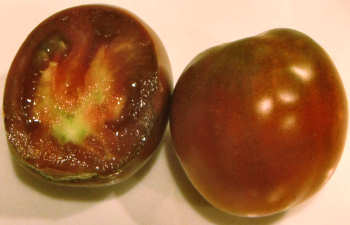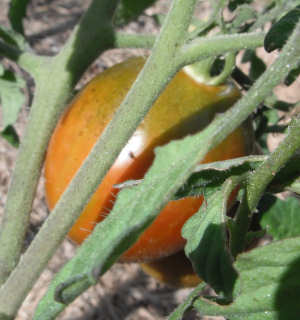Hybrid Tomatoes, a Few Weeks Later
It’s my first report on my hybrid tomatoes (see the original post here at hybrid tomato experiment). So how are all the plants doing? Well, there’s good news and bad news — here’s what’s happening.
I planted 8 F2 seeds, and all sprouted — good news so far, especially since they looked pretty good. Too bad it didn’t stay that way! (On the other hand, that’s the reason for experiments — you never know what will happen.)
Of my original 8 seedlings, four have survived. OK, 6 survived, but two of them were growing only so-so. Since I want plants that thrive, I pulled ‘em up and tossed them. Yes, it seems harsh, but I don’t need plants that don’t do well for me.
Hybrid Tomatoes That Survived
Of the four plants that have grown well, two are determinates, one is indeterminate and the other seems almost between the two — like a stocky indeterminate.
One of the determinates, plus the one that’s a definite indeterminate, have flowers — a good sign! So these two are in the running for keeping seeds from the tomatoes they produce. But does that mean that the other two don’t have a chance (except for eating what they produce)?
No, part of this experiment is on how they grow and how soon they produce, but the other part is the actual fruit — how large the tomatoes and even more important — how they taste. There’s really no reason to grow tomatoes that are bland or mushy in texture. So earliness is only part of the reason to grow a variety.
I also live in a very hot and humid place — it’s only April, but it’s been over 90 degrees several times already this season. So any plant that can grow and produce fruit in my location gets an automatic vote for keeping seeds from it.
Stay tuned!
Hybrid Tomato Experiment
This year in my tomato garden instead of growing heirloom tomatoes, I am growing all hybrid tomatoes. So why the change? It’s because I’m doing hybrid tomato experiment. Let’s see what’s going on.
A Review of Hybrid Tomatoes
So what is a hybrid? A hybrid is a plant that has two different parents. For example one parent can be a red tomato and the other parent can be one colored yellow. In my particular case I have a tomato plants that had two very different parents. One parent was a white tomato, and the other parent was a red tomato.
How do I know this? It’s because I have a packet of seeds for a white determinate tomato, and from that packet I got a plant that was an indeterminate red tomato. This means that my red tomato was a hybrid. An accidental hybrid probably, but it’s a hybrid nonetheless.
The F1 Generation
That red tomato that grew from a packet of white tomato seeds, was an F1 hybrid. But what is an F1 hybrid? It’s the first generation from a cross between two different parent plants.
Since I grew out more seeds from that particular packet and I got white determinate tomatoes, I suspected that my red tomato was F1 hybrid. However, I would not know that until I planted seeds from those red tomatoes. (The photo is of two of the fruits off the F1 plant.)
This year I planted eight seeds from the red tomato plant. And what did I get? I’ve got both indeterminate and determinate plants. This means that my red tomato was indeed an F1 hybrid cross.
The F2 Generation
My eight little plants growing this year are the F2 generation. These are the progeny of my F1 plant. What can I expect to get? Determinate and indeterminate certainly, but what about tomato size and color? That’s where things get interesting.
When it comes to tomato genetics, the color red is dominant over any other color. This means that I will undoubtedly get red tomatoes, can I expect any other color?
It’s hard to say. I might get some white determinate tomatoes, but with only eight seeds planted the chances are slim. That isn’t to say that I won’t get lucky!
My F1 plant had red tomatoes that were been 3 and 5 ounces each in size. However the white determinate tomatoes that I planted, had fruit that were about 7 ounces each. My hope is that I can get some nice red tomatoes in the 6 ounce size range.
As for the determinate plants that I have growing, I expect they will be red. However, you never know what kind of colors might show up; after all, this is a hybrid! And I have no idea what that red tomato was crossed with. The only thing I know for sure is that it was a determinant.
So stay with me, and we’ll see what these plants turn out to be. But I’ll keep you posted through the growing season. It certainly will be an interesting hybrid experiment!
Black Prince Tomato
The Black Prince tomato variety is a bit on the unusual side. First, it’s a very different shade — neither red nor black.
Next, it’s more of an oval shape, instead of round or beefsteak or even the standard “paste tomato” shape.
The picture you see here is one Black Prince tomato that’s pretty well ripe; you can see that it’s more of a mahogany color, rather than red or black.
The shape isn’t showing really well in this photo; it kind of looks like an oxheart shape, and it’s not.
The Black Prince variety is an heirloom tomato and comes to us from Russia, so it’s a fairly early tomato. In my Fall garden, it was the first to ripen fruits.
The plant itself is a little on the wimpy side, without a lot of leaves or stems. However, I have been impressed with the yield, which has been very nice indeed
How about a photo of one that’s still on the vine (albeit not quite ripe yet)?
This is in the sunshine, so the color is lighter, and once again, it’s not ripe. You might notice that it has “green shoulders” at the moment — the green mostly disappears as it gets fully ripe, but a greenish cast does remain.
Black Prince — Tomato Eating Time!
Here’s the big question…how does Black Prince taste?
I’m happy to say that the taste is very good. While some people say black tomatoes taste “smokey”, I didn’t find that to be true. Instead, it was a rich tomato taste – yum!
The flesh is a little soft, as with most varieties of black tomatoes, but reasonably firm nonetheless. There is a good mix of juice and flesh — not a dry tomato at all!
I’m glad that I grew Black Prince seeds in my Fall garden, and I look forward to a continued harvest, until frost (probably January for me).
Homegrown Tomatoes – 2010 Spring Garden
So it’s Spring 2010 and tomato plants are a growin’! I thought I’d make a video of a walk in part of my tomato garden, instead of just talking about it. Hope you enjoy!
And here’s the same garden, two weeks later!
Green Tomato Pie Recipe
The first time I ever had green tomato pie was almost my last. More accurately, I never would have tried a piece if I had known it was made from green tomatoes. How I would have lost out!
Since then I have tried a few different recipes, with varying results. But this week I’ve had to rescue a bunch of green tomatoes, so I figured it was high time for another go at making a green tomato pie.
And this was really yummy! I started out with the same basic recipe I normally use, then added a few twists.
So here’s my green tomato pie recipe — hope you enjoy it!
Gail’s Green Tomato Pie
- 2 deep-dish pie crusts (I buy ready-made, but you can make your own.)
- 1 medium to large Granny Smith apple
- 2 green tomatoes, roughly 6 to 8 ounces each
- 12 large strawberries
- 1 cup sugar (I used table sugar, but you can substitute brown sugar if you like)
- 1/2 cup flour
- Scant 1/4 teaspoon salt
- 2 tablespoons butter
Prepare pie crusts. If you use the ready-made frozen, let them defrost. If you’re making your own, make enough for 2 deep-dish crusts. You’ll be using 1 crust for the pie itself, and 1 crust for the top.
Preheat the oven to 350 degrees.
Mix the flour, sugar and salt in a small bowl. Spoon it around to mix thoroughly. Sprinkle several spoonfuls on the bottom of the crust you’re using for the pie.
Peel the apple, quarter and core. Slice apple and layer on the bottom of the pie crust. Sprinkle with a couple of spoons of the sugar/flour mix.
Slice up one one of the green tomatoes into fairly thin pieces and layer on top of the apples. Sprinkle with the flour/sugar mix and dot with a tablespoon of butter.
Slice the strawberries and layer over the green tomatoes. Sprinkle with more flour/sugar mix.
Slice up the other green tomato and layer over the strawberries. Sprinkle with the rest of the flour/sugar mix and dot with the remaining butter.
Put the other crust over the top of the pie and squeeze the edges to seal. Poke the top with a fork or knife for vent holes.
This ends up being a pretty juicy pie while it’s baking, so I like to grab a cookie sheet and line it with some foil before putting the pie on top of it and placeing in the oven (saves on oven clean-up).
Bake in 350 degree oven for about 50-55 minutes.
Let cool, then cut into wedges and serve with some whipped cream or ice cream. Serves 8, and I don’t even want to guess the calories or whatnot.
Green Tomato Pie Notes
You can play around with this recipe some. You can cut the sugar back to 3/4 cups, and you can substitute other fruits for the strawberries. The next time I make it, I’m going to try crushed pineapple. If you choose to try that, make sure the pineapple is very well drained.
I don’t think it will matter much what kind of flour you use; I used white bread flour. And next time, I’m going to try some white whole wheat flour, just to see what it’s like.
Interestingly enough, one of the green tomatoes I picked was actually starting to ripen in the center, so I got a really neat color effect. While I wouldn’t choose a ripe tomato for this pie (too juicy and probably mushy), a tomato just starting to blush might be interesting to use.
At any rate, I hope you try and enjoy this recipe!

